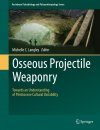![Osseous Projectile Weaponry Osseous Projectile Weaponry]()
Click to have a closer look
About this book
Contents
Customer reviews
Biography
Related titles
About this book
This volume presents the current state of knowledge on the osseous projectile weaponry that was produced by Pleistocene cultures across the globe. Through cross-cultural and temporal comparison of manufacturing methods, design, use methods, and associated technology, chapters in Osseous Projectile Weaponry identify and discuss differences and similarities between these Pleistocene cultures. The central research questions addressed in this volume include: (a) how did osseous weaponry technology develop and change through time and can these changes be tied to environmental and/or social influences?; (b) how did different Pleistocene cultures design and adapt their osseous weaponry technology to their environment as well as changes in that environment?; and (c) can we identify cultural interaction between neighboring groups through the analysis of osseous weapons technology – and if so – can we use these items to track the movement of peoples and/or ideas across the landscape? Through addressing these three central research questions, Osseous Projectile Weaponry creates an integrated understanding of osseous technology during a vital period in Modern Human cultural development which will be useful for students and advanced researchers alike.
Contents
- Late Pleistocene Osseous Projectile Technology and Cultural Variability
Part 1: Africa
- Osseous Projectile Weaponry from Early to Late Middle Stone Age Africa
- Bone Point Functional Diversity: A Cautionary Tale from Southern Africa
Part 2: Europe
- Early Upper Paleolithic Osseous Points from Croatia
- Spanish Aurignacian Projectile Points: An Example of the First European Paleolithic Hunting Weapons in Osseous Materials
- Projectile Weaponry from the Aurignacian to the Gravettian of the Swabian Jura (Southwest Germany): Raw Materials, Manufacturing and Typology
- Gravettian Projectile Points: Considerations about the Evolution of Osseous Hunting Weapons in France
- Upper Paleolithic Bone and Antler Projectiles in the Spanish Mediterranean Region: The Magdalenian Period
- A Review of the Osseous Projectile Points from the Upper Paleolithic of Portugal
- Diversity and Evolution of Osseous Hunting Equipment during the Magdalenian (21,000 - 14,000 cal. BP)
- Osseous Projectile Points in the Magdalenian: 'True' Points versus Pointed Waste-Products
Part 3: Southeast Asia & Australia
- Bone Technology in South Asia from Late Pleistocene Cave and Rockshelters of Sri Lanka
- The Walandawe Tradition from Southeast Sulawesi and Osseous Artifact Traditions in Island Southeast Asia
- Bone Projectile Points in Prehistoric Australia: Evidence from Implements, Ethnography, and Rock Art
Part 4: The Americas
- A Review of Late Pleistocene North American Bone and Ivory Tools
- Hunter-Gatherers of the Old and New World: Morphological and Functional Comparisons of Osseous Projectile Points
Customer Reviews
Biography
Michelle Langley is a Post Doctoral researcher in the School of Archaeology & Natural History at Australian National University. She received her PhD from the Institute of Archaeology at the The University of Oxford. Her current research is focused on the use of marine sourced raw materials for technology manufacture in early human communities. Her previous research has centered on investigating the maintenance (resharpening, repair, reuse, recycling) of Magdalenian barbed and unbarbed osseous projectile points; exploring the evidence for advanced and symbolic cognition in the Pleistocene archaeological records of Eurasia and Sahul (Greater Australia); and identifying the impact of taphonomic processes on these records. Issues surrounding the development and use of symbolic behaviour and social signalling technologies within Pleistocene Neanderthal and Modern Human populations remains the underlying focus of her research.















































